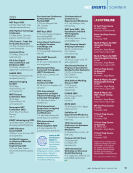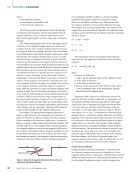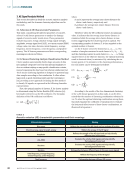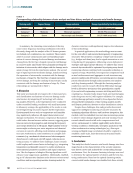deck imaging (ADI) systems, which have
been utilized nationwide by clients in
need of innovative bridge evaluation
solutions.
The acquisition also includes ABI’s
Utah office, which will help Infrasense
serve its western US clients more effi-
ciently and expand its presence in the
region.
Infrasense, founded in 1987, special-
izes in applying advanced technologies
to address challenges in subsurface
scanning. The company has been instru-
mental in advancing the field of NDE
through research and providing ongoing
services to clients nationwide.
ROSEN GROUP OPENS
NEW OFFICE IN INDIA
ROSEN Group celebrated the grand
opening of its newest office in
Navi Mumbai on 31 January 2025. The
ceremony was attended by longtime
business partners, industry colleagues,
clients, and employees, marking a
significant milestone for the company
in India.
The new office, which is part of
ROSEN Europe, is strategically located
to support the rapidly evolving energy
sector in India. The country’s increasing
investments in pipeline infrastruc-
ture, combined with new regulatory
requirements, are driving demand for
reliable and safe energy transportation
solutions.
The Navi Mumbai office will enhance
ROSEN’s ability to serve its clients more
efficiently by improving collaboration,
optimizing workflows, and strengthening
team dynamics. The facility is designed to
support the company’s goals of building
a strong local team, fostering closer
customer relationships, and enhancing
operational efficiency while maintaining
high quality standards.
“This expansion is more than just a
new location it represents our commit-
ment to pipeline integrity, and long-
term growth in the region,” said Jochen
Spalink, Director for Business Execution
at ROSEN Europe. “Moreover, it’s a hub
for collaboration, innovation, and deliv-
ering real impact.”
The opening also included a tradi-
tional Puja Ceremony, a blessing ritual
for success and prosperity, which was
a special moment for employees, their
families, and local partners.
Currently, the facility employs
15 people, with plans to expand by
15 to 30 more over the next few years.
This new location will serve customers
across India and Southwest Asia,
strengthening ROSEN’s presence in the
region.
INSIDE OF
HERCULANEUM
SCROLL SEEN FOR
THE FIRST TIME IN
ALMOST 2000 YEARS
In February, the Bodleian Libraries and
the Vesuvius Challenge announced a
breakthrough in the endeavor to decipher
text preserved on papyrus scrolls from
Herculaneum, an ancient site buried by
the eruption of Mount Vesuvius in 79 AD.
Researchers have successfully gener-
ated the first image of the inside of scroll
PHerc. 172, one of three Herculaneum
scrolls housed at the Bodleian Libraries
in the UK. This marks a significant step
forward in the recovery of ancient texts.
The image, which reveals a substantial
portion of the papyrus along with some
columns of text, shows the last 26 lines
of each column. University of Oxford
(England) scholars are working to inter-
pret the text, and the Vesuvius Challenge
(which Materials Evaluation covered
previously on page 8 of our April 2024
issue) invites others to join in the effort
to fully decode the content. One of the
first words to be translated is the Ancient
Greek word ιατροπή meaning “disgust,”
which appears twice in the text.
Scanned in July 2024 at the UK’s
national synchrotron facility, Diamond
Light Source in Harwell, the scroll’s
images were enhanced using AI tech-
nology. Researchers are further refining
these images with a new segmentation
technique, hoping to improve the clarity
of the text and potentially reveal the title
of the work, which may be preserved on
the innermost part of the scroll.
The scroll, donated to Oxford in the
early 19th century by Ferdinand IV, King
of Naples and Sicily, stands out due to
the unique chemical composition of its
ink. X-ray scans show the ink more clearly
than that of other scrolls, and researchers
believe the ink may contain a denser
contaminant, such as lead. Further testing
will be needed to confirm this.
The AI technology used in this project
is focused on detecting ink, without any
understanding of language or characters.
The transcription and translation of the
text will be handled by human scholars,
SCANNER
|
INDUSTRYNEWS
The ROSEN Team India. The office and operations teams in Navi Mumbai are now working under
the same roof to improve collaboration, optimize workflows, and strengthen team dynamics.
12
M AT E R I A L S E V A L U AT I O N • M AY 2 0 2 5
CREDIT:
ROSEN
GROUP
been utilized nationwide by clients in
need of innovative bridge evaluation
solutions.
The acquisition also includes ABI’s
Utah office, which will help Infrasense
serve its western US clients more effi-
ciently and expand its presence in the
region.
Infrasense, founded in 1987, special-
izes in applying advanced technologies
to address challenges in subsurface
scanning. The company has been instru-
mental in advancing the field of NDE
through research and providing ongoing
services to clients nationwide.
ROSEN GROUP OPENS
NEW OFFICE IN INDIA
ROSEN Group celebrated the grand
opening of its newest office in
Navi Mumbai on 31 January 2025. The
ceremony was attended by longtime
business partners, industry colleagues,
clients, and employees, marking a
significant milestone for the company
in India.
The new office, which is part of
ROSEN Europe, is strategically located
to support the rapidly evolving energy
sector in India. The country’s increasing
investments in pipeline infrastruc-
ture, combined with new regulatory
requirements, are driving demand for
reliable and safe energy transportation
solutions.
The Navi Mumbai office will enhance
ROSEN’s ability to serve its clients more
efficiently by improving collaboration,
optimizing workflows, and strengthening
team dynamics. The facility is designed to
support the company’s goals of building
a strong local team, fostering closer
customer relationships, and enhancing
operational efficiency while maintaining
high quality standards.
“This expansion is more than just a
new location it represents our commit-
ment to pipeline integrity, and long-
term growth in the region,” said Jochen
Spalink, Director for Business Execution
at ROSEN Europe. “Moreover, it’s a hub
for collaboration, innovation, and deliv-
ering real impact.”
The opening also included a tradi-
tional Puja Ceremony, a blessing ritual
for success and prosperity, which was
a special moment for employees, their
families, and local partners.
Currently, the facility employs
15 people, with plans to expand by
15 to 30 more over the next few years.
This new location will serve customers
across India and Southwest Asia,
strengthening ROSEN’s presence in the
region.
INSIDE OF
HERCULANEUM
SCROLL SEEN FOR
THE FIRST TIME IN
ALMOST 2000 YEARS
In February, the Bodleian Libraries and
the Vesuvius Challenge announced a
breakthrough in the endeavor to decipher
text preserved on papyrus scrolls from
Herculaneum, an ancient site buried by
the eruption of Mount Vesuvius in 79 AD.
Researchers have successfully gener-
ated the first image of the inside of scroll
PHerc. 172, one of three Herculaneum
scrolls housed at the Bodleian Libraries
in the UK. This marks a significant step
forward in the recovery of ancient texts.
The image, which reveals a substantial
portion of the papyrus along with some
columns of text, shows the last 26 lines
of each column. University of Oxford
(England) scholars are working to inter-
pret the text, and the Vesuvius Challenge
(which Materials Evaluation covered
previously on page 8 of our April 2024
issue) invites others to join in the effort
to fully decode the content. One of the
first words to be translated is the Ancient
Greek word ιατροπή meaning “disgust,”
which appears twice in the text.
Scanned in July 2024 at the UK’s
national synchrotron facility, Diamond
Light Source in Harwell, the scroll’s
images were enhanced using AI tech-
nology. Researchers are further refining
these images with a new segmentation
technique, hoping to improve the clarity
of the text and potentially reveal the title
of the work, which may be preserved on
the innermost part of the scroll.
The scroll, donated to Oxford in the
early 19th century by Ferdinand IV, King
of Naples and Sicily, stands out due to
the unique chemical composition of its
ink. X-ray scans show the ink more clearly
than that of other scrolls, and researchers
believe the ink may contain a denser
contaminant, such as lead. Further testing
will be needed to confirm this.
The AI technology used in this project
is focused on detecting ink, without any
understanding of language or characters.
The transcription and translation of the
text will be handled by human scholars,
SCANNER
|
INDUSTRYNEWS
The ROSEN Team India. The office and operations teams in Navi Mumbai are now working under
the same roof to improve collaboration, optimize workflows, and strengthen team dynamics.
12
M AT E R I A L S E V A L U AT I O N • M AY 2 0 2 5
CREDIT:
ROSEN
GROUP













































































